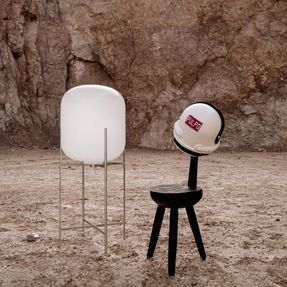
Pulpo ODA Table And Floor Light
ODA TABLE AND FLOOR LIGHT
Directly inspired by the industrial monuments photographed by the famous Dusseldorf Becher School, Sebastian Herkner bundles up their outer shape and inner function of a steel casting foundry for oda.
As a result, the glowing homage to light is a source for cosiness and has since then become a reference to contemporary lighting design.
DESIGNER
SEBASTIAN HERKNER
Poetic compositions, refined shapes and delicate surfaces mark his designs: Sebastian Herkner who founded his Offenbach am Main based studio in 2006, creates furniture, lighting and textiles, as well as spaces and installations – often combining contemporary techniques with traditional craftsmanship. Without leaving out the importance of material and sensory beauty, the multifaceted designer follows a strong conceptional approach
“I transport and interpret characteristics from various contexts of society and culture, and implement them in new artefacts”, says Sebastian Herkner.
Repeatedly awarded, the design teaches at the university, collaborates with fairs as well as museums, and works for some of the most prestigious design manufacturers of our time. pulpo got to know the creative mind during various international design shows, as he was still a student.
Today, the designer and the house of design are bound by a close and friendly relationship, allowing a dynamic exchange when playing creative ping-pong over ideas or figuring out the ideal design language for pulpo.
INFORMATION
BRAND
Pulpo
PRODUCT TYPE
Table/Floor light
CABLE
-Textile, 3000mm with hand switch and euro-plug -Textile, 4000mm with foot switch and euro-plug
DOWNLOADS
↓ 3 D
↓ Data Sheet
↓ Care Instructions
SIZE
- Oda small Table Light
- Oda Medium Floor Light
- Oda In Between Floor Light
- Oda Big Floor Light
RADIATION ANGLE
360°
LUMEN
- 105 lm
- 260 lm
COLOUR TEMPERATURE
- 2500 K
- 2100 K
POWER CONSUMPTION
- 1 Watt
- 4 Watt
VOLTAGE
220–240; 50/60 Hz
LIFETIME
30000 h
DESIGNE
Sebastian Herkner
YEAR OF DESIGN
2014
PROCESS
The oda is a masterwork of traditional craftsmanship. Each lamp is handmade and has characteristic features such as irregularities in glass thickness, colour variations, small bubbles or bumps in the glass or the base.
POWER CONSUMPTION
4 Watt
VOLTAGE
220–240; 50/60 Hz
GLASS CLEANING
For dusting and light cleaning of glass use a soft, dry cloth. For further cleaning gently wipe the surface with a soft cloth wrung in clean water and a non-abrasive commercial glass cleaner. Dry immediately afterwards with a soft, dry and clean cloth. Please note that bubbles, streaks and other variations in size and colour are part of the production process, and not defects of the design or production of handmade glass.
DIMENSIONS
- Oda small : Ø240×450 H
- Oda Medium : Ø450×850 H
- Oda In Between : Ø450×1112 H
- Oda Big : Ø450×1400 H
BULB
- LED filament
- LED filament dimmable
BULB FITTING
- E14 240 Volt
- E27 240 Volt
SHADE
Handblown Glass, Coloured
FINISH
Warm White
BASE
- Steel, half-round tube ø8mm, powder coated, chrome plated or brass
- Steel, half-round tube ø16mm, powder coated, chrome plated or brass
CARE INSTRUCTIONS
Regular cleaning and maintenance is important in order to keep your pulpo product looking its best and to prolong its life. Always remove any kind of dirt as soon as possible. We recommend that you first test a small, invisible area to ensure that no colour change or damage arises to the product. Do not use materials for maintenance that contain abrasive agents or are basic, acid or organic.
METAL CLEANING
For dusting and light cleaning of the base, use a soft and dry cloth. For further cleaning, gently wipe the surface with a soft cloth wrung in clean water and a neutral detergent or soap flakes of good quality. Dry immediately afterwards with a soft, dry and clean cloth. For the best maintenance of the product, care for it regularly, protect it against direct sunlight and heat, and try to keep it away from moisture, grease, and other dirt. Furthermore, protect the surfaces against sharp objects and other that might scratch. Please note that brass may develop a patina over time. The darkening of the surface is due to oxidation. If left untreated, the surface will eventually turn entirely darker.
GALLERY














